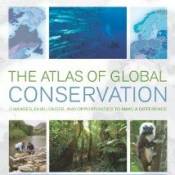A Picture May Say a Thousand Words, but the New Atlas of Global Conservation Speaks Volumes
How do you put global biodiversity loss into perspective? With images, of course. “The Atlas of Global Conservation,” filled with full-color maps, graphics and essays overcomes boundaries and borders, pulling into a single accessible atlas the often precarious state of nearly every habitat on earth.

7 January 2011 | The Nature Conservancy’s new book, “The Atlas of Global Conservation” offers an unblinking look at the current crises of biodiversity loss. Rich with graphic detail, the atlas allows readers to visually understand projects within a greater context, framing industries, nations and missions. Focused on habitats, species, and change, this atlas, edited by Jennifer L. Molnar, allows readers, particularly those working in the field of global conservation, to explore available mitigation options. It places these options into a global context within the worldwide ecosystem services crisis.
Small picture vignettes display specific conservation issues. Short personal stories by conservation leaders provide insights into specific topics. And outstanding graphics illustrate the scope of the global ecosystem services crisis.
A World of Change
In the chapter I found most useful, titled “A World of Change”, Martin Wikelski and David S. Wiclove use data to clearly display the conflict between man’s consuming nature and its repercussions on our planet’s health. The chapter juxtaposes the reality that while more than one out of every five individuals on Earth lacked safe drinking water last year, people from other nations with very different standards of living – the US, India, and China — consume the most water globally, averaging between 300-646 billion cubic meters per person per year.
The chapter also provides a strong depiction of increased global temperatures and their association with climate disruption. It documents how temperatures increased by only 0.74˚C over the past 100 years. And it illustrates how temperatures are expected to escalate by more than twice that amount, between 0.4˚C to 1.0˚C, in the next twenty years alone.
Local actions with global impacts
Interlocking themes and activities proposed for project developers link this to the next chapter, “Habitat Loss,” and mirror the book’s overall message that individual impacts on nature have interlocking and global impacts. Readers can view conservation and reforestation activities in Brazil’s Atlantic forest and the US Mississippi Alluvial Valley. They can see how mitigation strategies counteract climatic disruption. And they can make the connection between activities that mitigate climate change and their accompanying benefit for habitat gain. Pages focused on illegal wildlife trade, meanwhile, graphically illustrate how these sales cross political boundaries to sell entire species into extinction. Finally, pages devoted to disappearing glaciers offer graphic representation of snowmelt changes worldwide. Their analysis of weather patterns dating back to 1975 and weather forecasts extending to 2040 illustrate that climate disruption will cause the majority of the Northern Hemisphere to experience snowmelts one-to-three weeks earlier than they do today.
“The Atlas of Global Conservation” offers an illustrated guide that demonstrates and puts in context of the global ecosystem services crisis we now face. Through maps, analysis and insights it provides tools for regional, national and worldwide ecosystem service maintenance and strategies for improvement.
Please see our Reprint Guidelines for details on republishing our articles.

